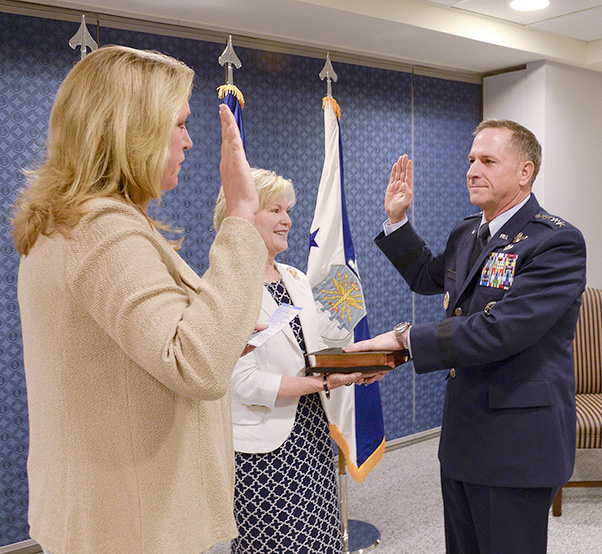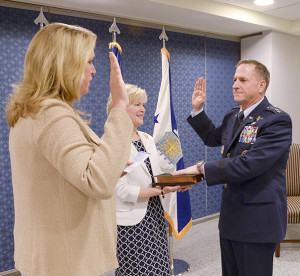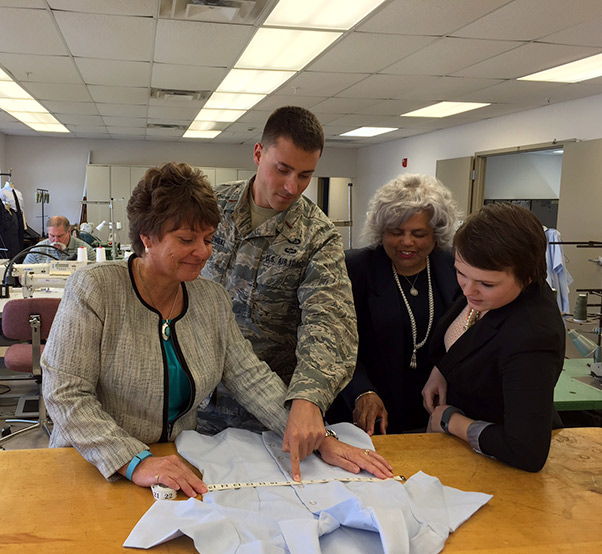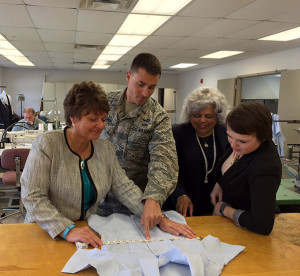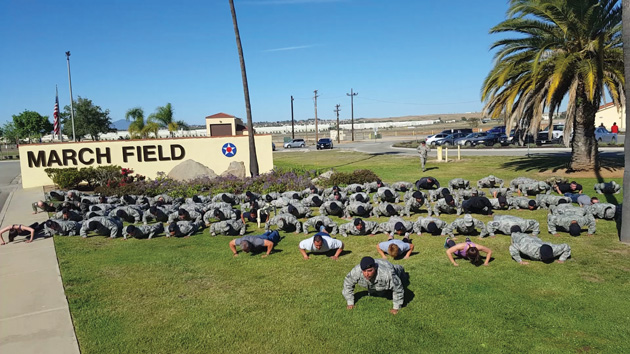BEACON CHANGES PUBLISHERS
The Beacon staff would like to thank Aerotech News and Review for their many years of publishing. This is the last issue they will produce. Look for a few changes in format for our next Beacon, which will be published by Golding Publications.
CHIEF INDUCTION CEREMONY
The March Field Chiefs Group cordially invites all March to attend the Chief Induction Ceremony Saturday May 21, 2016 at 5:30 pm in the Hap Arnold Club Ballroom. Attire for the event is Mess dress for military and business attire for civilians. R.S.V.P. by May 6, 2016. Call 951-655-3520.
COMMISSARY CASE LOT SALE MAY 5-8
Your March ARB commissary will have their May 2016 Case lot sale May 5-8. They will have savings of up to 60% on cases of your favorite products. Come out and take advantage of your benefit and save big with great prices on paper products, detergents, cereal, pet food and cases of can goods. They will also be offering great savings again this case lot on Johnsonville
sausage while supplies last. Don’t forget to check out the great prices offered in their meat and produce departments. There will be refreshments provided courtesy of their commissary vendors. The commissary is located east of March ARB at the crossing of 6th Street and Meyer Drive. Your March Commissary, It’s Worth the Trip!
VOLUNTEER VICTIM ADVOCATES NEEDED
The SAPR Program March ARB is looking for a select group of individuals to act as volunteer victim advocates with the Sexual Assault Prevention and Response Program, March ARB. Basic requirements include: Formal application, approval from the volunteers’ commander and 40 hours of Victim Advocate training from an Air Force approved course. Applicants will then be required to apply for certification with the National Organization of Victim Advocates (NOVA). There will be a 40-hour course offered at March ARB on May 2. Applicants to the program must have clean background check, possess excellent communication skills, be of outstanding character and judgment and willing to respond to incidents of a very personal nature with great discretion while adhering to Air Force protocol in respect to the SAPR program. Please contact the SAPR office March ARB at 951-655-4551 or email at frank.pavone@us.af.mil
EDUCATION & TRAINING OFFICE TO PROVIDE MASS BRIEFINGS
The March Education and Training will hold mass briefings on Sundays during each Unit Training Assembly for any Tuition Assistance, GI Bill and Community College of the Air Force (CCAF) inquiries. Their schedule is as follows:
Community College of the Air Force (CCAF) 8 – 8:30 a.m.
Tuition Assistance/GI Bill 8:30 – 9 a.m.
There is no need to sign up for the briefings. For more information, contact the March Education and Training office at 951-655-6739.
FY16 UTA RESCHEDULE GUIDELINES
Brig. Gen. Muncy has determined that the following FY 16 Unit Training Assemblies may only be rescheduled if the reschedule date is for the alternate UTA during the same month of the A and B UTAs for the months of May and August 2016. The wing commander will authorize reschedules outside of the same month, if absolutely necessary, on a case-by-case basis.
REGISTER FOR YELLOW RIBBON EVENTS
Upcoming dates for Yellow Ribbon events are May 20-22, Jun 17-19. For more formation, contact 1st Lt. Shelley Lawrence, your 452nd Air Mobility Wing Yellow Ribbon representative, for details at 951-655-4615.
BACK STREET GRILL HOURS
Hours of operation for the newly renovated Back Street Grill are Monday – Friday for breakfast from 6:30 to 10 a.m., for lunch from 11 a.m. to 1:30 p.m.; UTA weekends for breakfast (Sat & Sun) from 5:30 to 9 a.m., for lunch (Sat & Sun) from 11 a.m. to 1:30 p.m., for dinner (Sat only) from 4 to 8 p.m. Additionally, the Back Street Grill proudly serves Starbucks Monday – Friday from 6:30 a.m. to 3 p.m. and UTAs (Sat & Sun) from 6 a.m. to 3 p.m.
GRILL NIGHT AT SALLY’S ALLEY
Every Wednesday night starting at 4 p.m., Sally’s Alley is open for business with Grill Night. For more information, call them at 951-653-2121.
FITNESS CENTER NEWS
The March Fitness Center has received the Wellbeats Virtual Group Fitness Kiosk. This kiosk allows members to participate in virtual fitness classes.
Daily WellBeats Fitness Schedule is:
Mondays: 10:30 a.m. – REV (spin); 12:15 p.m. – Yoga
Tuesdays: 12:15 p.m. – Fit for Duty; 4:00 p.m. – REV
Wednesdays: 6 a.m. – Yoga/Pilates; 11 a.m. – V.I.B.E./Toning; 12:15 p.m. – REV
Thursdays: 11 a.m. – REV; 12:45 p.m. – Fit for Duty
Fridays: 11 a.m. – Core; 11:15 a.m. Pilates
Wellbeats offers many more classes available at the members’ request.
FIP (Fitness Improvement classes) available through our Wellbeats Kiosk.
Additional opportunities for fitness:
Tuesday, 11 a.m. and Thursday, 12:15 p.m. – Battle ropes training
Monday, 10:30 a.m. and Wednesday, 11:30 a.m. – TRX
A & B UTA Saturdays, 7 a.m. – Wellbeats Fit for Duty
A & B UTA Sundays, 7 a.m. – Wellbeats REV
A UTA Saturdays, 5 p.m. – Virtual Strength “Fit for Duty”
B UTA, 5 – 7 p.m. – Pick-up basketball
Coming in 2016: Inter-Services Golf Tournament, Team Cohesion Challenge, Armed Forces 5K Run.
Call the Fitness & Sports center at 951-655-2292 to sign up or for more information on these programs.
Class descriptions:
Circuit Training – a high intensity interval training class that integrated cardio and muscular endurance exercises
Core – various classes from our WellBeats system that focus entirely on working out your core
Fit for Duty – a high-energy, extreme, conditioning workout led by service members with expertise in fitness training
Functional Fitness – A type of high-intensity interval training combining cardio and weight training into one short but intense class with mobility drills, mountain climbers, lunges, push-up, kettlebells, goblet squats duck walk, run.
Fusion – an integration of yoga and Pilates exercises with attention to breath, form, flow and body balance.
Kinetics – a total body, multi-activity class that includes sports-style cardio intervals with resistance training circuits and muscle isolation work
REV – an indoor cycling class that combines sprints, climbs, intervals, drills, terrain, and technique training
Stomp – a total body, cardio-driven step class as it was originally meant to be taught
TKO – a blend of martial arts disciplines that includes a combination of punches, kicks, and strikes
TRX – introductory class that teaches basic exercises to strengthen core and transition into more advanced techniques on the TRX suspension system
V.I.B.E. – multi-dimensional dance exercises ranging from Latin to urban, hip-hop and more
Zumba/Zumbathon – well-known dancing class featuring exotic rhythms set to high-energy Latin and international beats (Zumbathon is a two-hour Zumba class in which participants can win prizes.)
OUTDOOR REC UPCOMING 2016 TRIPS
| The outdoor recreation division has scheduled trips for target audiences of Single Airmen (SAP), Pre/Post-Deployers (RecOn) and Deployed-affected family members (DP). There is special pricing for these members (SAP/RECON/DP column). All others (military/DOD ID card holders and their guests) are invited on a space-available basis at the higher, per-person price listed in the EOE column. Reservations are on a first-come, first-served basis, and can be made by contacting ODR at 951-655-2816. |
| DATE – TRIP |
SAP/RECON/DP |
EOE |
| May 13-15 – Whitewater Rafting |
DE – $30 |
$130 |
| May 28 – Deep Sea Fishing |
SAP- $25 |
$102 |
| Jun. 10-12 – Spelunking |
SAP – $40 |
$110 |
| Jun. 18 – Skydiving |
SAP – $40 |
$199 |
| Jul. 16 – Couples Ballooning |
RecOn/DE – $30 |
$148 |
| Jul. 30 – La Jolla Kayaking |
RecOn/DE – $15 |
$70 |
| Aug. 13 – Catalina Adventure |
RecOn/DE – $40 |
$150 |
| Aug. 27 – Bridge to Nowhere Bungee Jumping |
SAP – $20 |
$85 |
| Sep. 3 – Skydiving |
RecOn/DE – $40 |
$199 |
| SEP. 3 – Zipline/segway tour |
SAP – $40 |
$200 |
| Sep. 17 – Deep Sea Fishing |
RecOn/DE – $25 |
$102 |
| Sep. 24 – Tandem Hang Gliding |
RecOn/DE – $50 |
$199 |
OUTDOOR REC EQUIPMENT RENTALS
Outdoor Recreation has a variety of equipment for rent such as camping gear, water sports equipment, bicycles, and trailers to carry it all! Special orders for Callaway, Odyssey, Cleveland, Never Compromise, Nike, Bag Boy, Sun Mountain and Staff golf equipment are also available. Download the full equipment rental price list at MarchFSS.com, call 951-655-2816 or come on by for more information.
MARCH TICKETS & TOURS
Amusement Park Specials
Castle Park: $16 per person includes unlimited rides, water park access, miniature golf and the new Sky Rider.
Disney 3-Day Park Hopper military special: $140 per person (adult/child)
Discount Movie Tickets
Available for only $10 each and valid for Regal Cinemas, United Artists Theatres and Edwards Cinemas.
Hotel Discounts
Receive 10% off any Best Western and 15% off any Choice Hotel
Visit the Tickets & Tours page at MarchFSS.com and download the Discount Ticket Price List for a full list of discounts tickets prices, hotel discounts and special promotions. Call Tickets & Tours at 951-655-4123 for more information.
